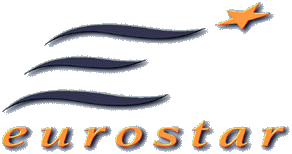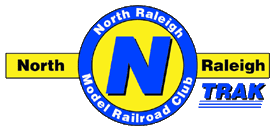 The first class ticket read Car 10, Seat 24, Train 9019, departing Paris Gare du Nord at 1019, arriving London Waterloo at 1213. Three of us decided to try the train rather than fly; perhaps the other two only agreed when I said I was definitely going by train no matter how they went. The first class ticket read Car 10, Seat 24, Train 9019, departing Paris Gare du Nord at 1019, arriving London Waterloo at 1213. Three of us decided to try the train rather than fly; perhaps the other two only agreed when I said I was definitely going by train no matter how they went.
Gare du Nord in Paris is over 100 years old, and is a station in the traditional style, with a large trainshed. Two of the tracks were partitioned from the rest by a fence and gates, and are reserved for the Eurostar. Most of the remainder of the about 16 tracks were occupied by TGVs, with about 4 tracks for commuter trains.
All facilities relating to the Eurostar are separate from normal facilities at both Gare du Nord and Waterloo. In Paris, Eurostar passengers are directed up a set of stairs to the Check-in Gate; check-in opens 10 minutes after the departure of the next earlier Eurostar. After ticket inspection by a smartly dressed attendant, passengers are directed to the appropriate first- or second-class waiting room. The first-class waiting room is very similar to an Admirals Club or Crown Room here in the US, as are its amenities.
Second class passengers board the train starting 20 minutes before departure, while first class passengers board 10 minutes before departure. There is no checked baggage; it is carry-on just like a plane, but there are baggage racks at the end of each car (which is why each piece of baggage must have a Eurostar ID tag attached which specifies name, train, car and seat), plus overhead racks above the seats.
When called to board, each passenger passes by a card reader that reads the magnetic stripe on the ticket. The ticket is not collected, nor is a boarding pass issued. Each passenger then proceeds through the lounge to a stairway and escalator which leads down to the platform. You then walk along the platform to the assigned car. Each car is clearly numbered, and there are signs that direct you forward or rearward to the appropriate car. Attendants stand at each vestibule to assist in checking tickets, welcoming passengers on board and assisting with placing baggage in the racks.
There are 31 trainsets making up the Eurostar service, each with 18 cars (16 passenger coaches and two bar cars) with a locomotive (called a power car) at each end, approximately a quarter of a mile long. They are painted in a pleasant off-white color with blue and yellow accents, and are shaped like a TGV. Six of the coaches are first class, and are grouped at the center of the train. The second class portion of the train consists of a bar car then five coaches at each end of the first class section. Seating capacity of the first class coaches range from 27 to 39, and second class coaches from 52 to 60. Total seating capacity is 766, equivalent to two Boeing 747s.
The electrical system in the locomotives was designed to operate on both the British and French railways, using third rail pickup in the UK and catenary in the Channel Tunnel and France. Changeover is made without stopping, just on the British side of the tunnel.
Eurostar service operates between London and Paris, and London and Brussels; some trains stop at Ashford, England (just before the tunnel entrance) and/or Lille, France. Service is being extended to Manchester, England and to Glasgow and Edinburgh, Scotland, all overnight service.
The first-class car seats people in a 2 + 1 configuration (second-class is 2 + 2). Each pair of rows face each other across a table on which is placed a small lamp. This table has a hinged top, which opens to increase the surface area when seated. Entry to the car is spacious, with the baggage rack area just to one side, and the washroom across from the door. All doors (exterior, end of car, and washroom) are electrically operated (with manual override). The interior of the car was decorated in rust and two shades of gray.
The seats were comfortable, and the table was at the correct height for comfortable reading, eating or working. Our coach contained only 6 passengers on this trip, including the three of us, an elderly French couple obviously going to London as tourists (they were reading guide books to London) and a French salesman who spent most of the trip using his cellular phone.
Announcements on the train are made in both English and French. While in France the French announcement is first, then English, and while in England the English announcement is first, then French. Announcements indicated 5 minutes, then one minute to departure, then announcing the doors are about to close.
By my watch, the Eurostar began to move 3 seconds after its scheduled departure time of 1019! The first few miles were on normal tracks through Paris and its suburbs at normal track speed. Once the dedicated high-speed track was reached it did not take the Eurostar long to accelerate to "normal" speed. The PA announced the Eurostar had reached its maximum speed of 300kph (186mph).
The ride was very smooth, and gave no indication of the speed. Amtrak in the Northeast Corridor provides a much rougher ride at 125mph than the Eurostar at 186mph. When traveling through the countryside you do not get a true sensation of the high speed. It is only when there is a parallel highway, where you know the vehicles are moving at 60-70mph, that the speed becomes obvious. You go past so fast that you cannot even read the names on the side of the 18-wheelers!
A few miles south of Lille it appeared to be getting foggy outside the train. However, it was snowing. The speed of the train made it almost impossible to distinguish snowflakes, and it appeared like fog.
Since Train 9019 is a mid-morning train, a full meal was not served. Instead we were offered a selection of sandwiches, morning pastries, and beverage service. All were handled at our seat by two hostesses with an airline style cart. The "galley" was at the end of one car in the middle of the 6 first-class coaches. The food was good and the service excellent, as the hostesses continually walked through the cars.
We walked through the train from end to end. The second class coaches forward and back of the first class coaches each include a buffet-lounge-bar car where food and refreshments are sold to passengers. The selection included normal French and English food, but also included hamburgers and pizza. Prices were not too bad, considering the position of the US dollar vs the Franc or Pound.
The washroom in the first class coach was large and spacious, rivaling some hotel bathrooms I have encountered. Someone in a wheelchair would have no difficulty at all maneuvering in the washroom. Handles for support were mounted all over.
The route of the Eurostar follows the high-speed track that runs from Paris to Brussels. At Lille in northern France, the track splits west to the Channel Tunnel. From the England end of the tunnel to London, the train follows normal British Rail track that carries freight and commuter traffic as well as the Eurostar. Contracts have been awarded for the construction of a high-speed track from the tunnel to London Waterloo; this track should be complete early in the next century.
Customs and Immigration are handled on the train. After leaving Lille, French officials walked through the train checking passports, and stamping non-EEC people out of France. A few minutes later, British officials walked through, stamping passports with entry into Great Britain. The stamp in my passport says "Channel Tunnel."
Just before entering the Channel Tunnel, the PA system announced that travel through the tunnel would take about 20 minutes. A check of my watch at entry and again at exit indicated we had made the crossing in just over 14 minutes. Construction of the tunnel is such that the normal piston effect of a train going through a tunnel is totally eliminated - there are "piston relief ducts" located every 270 yards through the tunnel. There was absolutely no change in air pressure on entering the tunnel or while traversing through it.
Near the tracks shortly after exiting the tunnel were the giant tunnel boring machines used in the construction of the tunnel. One of them had a sign which said "For Sale - Used Once."
The most obvious difference about the trip from the channel to London is the much slower speed of the train. The track has not been upgraded for high speed travel (not scheduled to be complete until 2003) and is shared with all types of trains including freight and commuter, so the speed limit is 60mph, except for a few miles near the tunnel where the speed limit is 100mph. Once upgraded, travel time between Paris and London will be reduced by 30 minutes.
London Waterloo is, like Paris Gare du Nord, a station in the traditional style, also with a large trainshed. However, a new addition was built to handle the Eurostar, so Eurostar traffic and passengers are totally separated from the regular station.
When the Eurostar pulled to a stop in Waterloo Station, my watch said 27 seconds past the 1213 scheduled arrival time. Note the trip actually takes 2 hours, 54 minutes, since there is an hour time difference between France and the UK.
The fare for the trip was $176.00, for unrestricted first class travel. With certain restrictions, the cheapest one-way fare is $76.00. Not bad, and very competitive with the airlines.
Some 60 million people travel annually between London and Paris. Pre-Eurostar some 55% of these flew. Now some 22% travel on the Eurostar.
|
